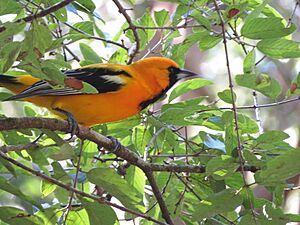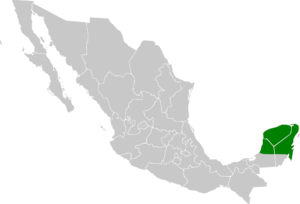Orange oriole facts for kids
Quick facts for kids Orange oriole |
|
|---|---|
 |
|
| Conservation status | |
| Scientific classification | |
 |
The orange oriole (Icterus auratus) is a small, colorful bird. It has bright orange feathers and belongs to the Icteridae family. You can find it in the Yucatán Peninsula in Mexico. This bird has a slim body, long wings, and a pointy beak. Its feathers are a vibrant orange, just like the fruit! It also has cool black marks on its wings and tail.
People know the orange oriole for its beautiful song. You can spot these birds in forests and gardens. They eat many different things, which helps give them their bright orange color. Some experts think this bird should be called the "Yucatan Oriole." This is because they are only found in Southeast Mexico. The orange oriole is not an endangered species. It is considered "least threatened," meaning its population is stable.
Contents
How to Spot an Orange Oriole
Orange orioles are about 19 to 21 centimeters (7.5 to 8.3 inches) long. They do not have different types or subspecies. Their feathers are mostly orange and black.
Male vs. Female Orioles
Male orange orioles have a black area between their eyes and beak. They also have a black stripe across their upper chest. Their head and body are bright orange. The smaller feathers on their wings are orange. The medium and larger wing feathers are white.
Female orioles look a bit different. Their heads and undersides are not as bright. Their backs are more green. Females have an orange-yellow color that is duller than the males.
Sounds and Calls
The orange oriole makes sounds that go up and down like whistles. It often sounds like a fast "chuchu chuchu" or "nyeek." These unique calls help them communicate with each other.
What Orange Orioles Eat
The orange oriole eats many different things. Their diet includes various insects, fruits, and sweet nectar. They especially like to eat from two native trees. One is called Talisia olivaeformis. The other is a medicinal tree called Metopium brownie.
To get the fruit from the Talisia olivaeformis tree, the oriole uses its beak. It pries open the hard shell. Then, it pulls out the soft fruit inside. They often look for food alone. But sometimes, they forage in pairs with other orioles. The colorful foods they eat give them the bright orange pigments in their feathers.
Where Orange Orioles Live
Orange orioles live in the lowlands of Mexico. They stay in the country all year round and do not migrate. You can find them in forests, woodlands, and even old farmlands. The type of place they live can also affect their feather color. This is because different habitats offer different kinds of food.
Conservation Status
This bird species is not considered globally threatened. Its population is decreasing a little, but not at a worrying speed. Experts from Partners in Flight estimate there are about 50,000 orange orioles. They are usually seen as common to fairly common birds.
Reproduction and Nests
The breeding season for orange orioles is in July. They often breed in large groups called colonies. These colonies can have 20 to 35 nests. Sometimes, they even build up to five nests in one tree!
Their nests are made from black and yellow fibers. They attach these nests to tree branches. Each nest is about 7.5 centimeters (3 inches) wide. They are also about 12.5 centimeters (5 inches) deep. Orioles build their nests high up in trees. They also like to build them near natural water holes.


